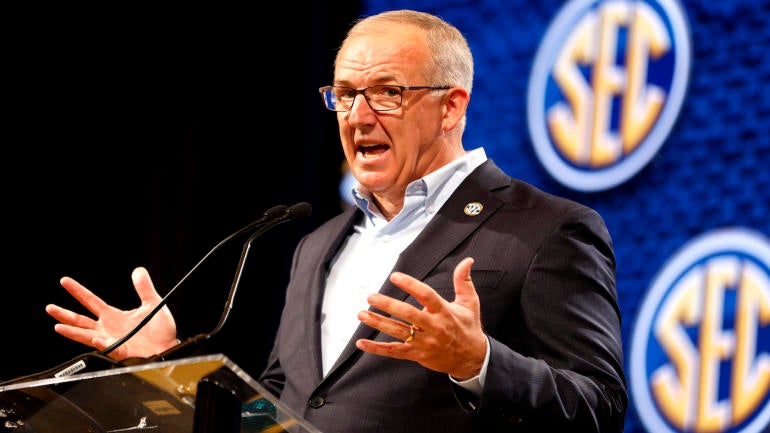
The Big Ten and SEC announced Friday they are banding together to form a joint advisory group with the goal of addressing the "significant challenges" facing college sports. The move comes as the NCAA struggles to govern intercollegiate athletics amid a sea of change that has imperiled the longstanding amateur model.
"The Big Ten and the SEC have substantial investment in the NCAA and there is no question that the voices of our two conferences are integral to governance and other reform efforts," Big Ten commissioner Tony Petitti said. "We recognize the similarity in our circumstances, as well as the urgency to address the common challenges we face."
Participants in the advisory group will include university presidents, chancellors and athletic directors. Athletes and "other constituencies" will be included as necessary, according to the announcement. Specific members of the advisory group have not been determined. Among the challenges the leagues cited in the formation of their partnership are "recent court decisions, pending litigation, a patchwork of state laws, and complex governance proposals."
"There are similar cultural and social impacts on our student-athletes, our institutions, and our communities because of the new collegiate athletics environment," SEC commissioner Greg Sankey said. "We do not have predetermined answers to the myriad questions facing us. We do not expect to agree on everything but enhancing interaction between our conferences will help to focus efforts on common sense solutions."
Friday's announcement clarified the body "will have no authority to act independently and will only serve as a consulting body." Still, this marks the latest move by the nation's two most powerful conferences to take an active role in determining the future of college sports.
The Big Ten is expanding to 18 schools in the 2024-25 academic year, while the SEC is expanding to 16. Both conferences are also entering massive new media rights agreements worth hundreds of millions of dollars per year at a time when the future of athlete compensation has become a central debate.
Significant symbolism
College sports are already awash with committees, boards, task forces and advisory groups. The failed 2021 "alliance" between the Big Ten, Pac-12 and ACC is a prominent example in recent history of big-picture conference collaboration amounting to nothing. The Big Ten and SEC even acknowledged their lack of authority to act independently in the announcement.
What's most striking from Friday's announcement is the symbolism of the two most powerful leagues in college sports banding together as they expand to include 34 of the country's most powerful brands. The group's charter and timetable remain undetermined, as do the specific challenges it will tackle.
But the news — however light on detail — will only further fuel the perception of an inevitable breakaway by the country's most valuable athletic departments. Even NCAA president Charlie Baker announced a proposal in December for a new subdivision of Division I schools for football governance purposes.
There will be few stronger voices in that conversation than the Big Ten and SEC stakeholders who will soon comprise the joint advisory group. If there is going to be a new subdivision centered on a revenue-sharing model, as Baker proposed, then this group could help set the agenda, even as they operate outside the NCAA's purview.
Top challenges
There is no shortage of issues for the group to address. The college football recruiting calendar is a mess. Athletes are on the cusp of securing the freedom to transfer as many times as they want. The NCAA is cracking down on the use of NIL as a recruiting inducement but is being sued for doing so. Conferences are now widely constructed as coast-to-coast ventures with little regard for the practicality of scheduling in sports outside of football. The list of problems is practically endless.
However, one that stands above the rest is the future of athlete compensation. The NCAA is facing a growing number of legal challenges that could lead to precedents striking down the old amateurism model for good. Because of their joint wealth, the Big Ten and SEC are uniquely equipped to address that issue in tandem. With Congress hesitant to get involved and the NCAA floundering, the two leagues could begin to establish a framework for what the next iteration of college sports will look like for their members.
















